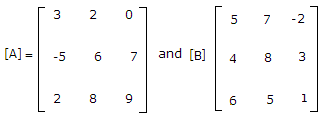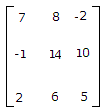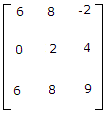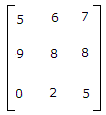Discussion
Home ‣ Electronics and Communication Engineering ‣ Signals and Systems Comments
- Question
The final value theorem is
Options- A.
![The final value theorem is £f(t) = £-1F(s) = f(t) £[a f1(t) + bf2(t)] = aF1(s) + bF2(s) where £[f(t](../../../imagesresources/questions-resources/HWFIoNskMxnqSavr.png)
- B.
![The final value theorem is £f(t) = £-1F(s) = f(t) £[a f1(t) + bf2(t)] = aF1(s) + bF2(s) where £[f(t](../../../imagesresources/questions-resources/mCVLWVvgEhZxNlZs.png)
- C.
![The final value theorem is £f(t) = £-1F(s) = f(t) £[a f1(t) + bf2(t)] = aF1(s) + bF2(s) where £[f(t](../../../imagesresources/questions-resources/CWnnpxafoJzBJVok.png)
- D.
![The final value theorem is £f(t) = £-1F(s) = f(t) £[a f1(t) + bf2(t)] = aF1(s) + bF2(s) where £[f(t](../../../imagesresources/questions-resources/pCtRuJWZwptiqhyS.png)
- Correct Answer

Explanation£f(t) =![The final value theorem is £f(t) = £-1F(s) = f(t) £[a f1(t) + bf2(t)] = aF1(s) + bF2(s) where £[f(t](../../../imagesresources/questions-resources/vHlDfpFzPHZpILtI.png)
£-1F(s) = f(t)
£[a f1(t) + bf2(t)] = aF1(s) + bF2(s)
![The final value theorem is £f(t) = £-1F(s) = f(t) £[a f1(t) + bf2(t)] = aF1(s) + bF2(s) where £[f(t](../../../imagesresources/questions-resources/AiKlMfHVgpVZGrKd.png)
![The final value theorem is £f(t) = £-1F(s) = f(t) £[a f1(t) + bf2(t)] = aF1(s) + bF2(s) where £[f(t](../../../imagesresources/questions-resources/EZExrPwjsyzzeKBT.png)
![The final value theorem is £f(t) = £-1F(s) = f(t) £[a f1(t) + bf2(t)] = aF1(s) + bF2(s) where £[f(t](../../../imagesresources/questions-resources/NdxqvZhmTAFkdpyS.png)
where
![The final value theorem is £f(t) = £-1F(s) = f(t) £[a f1(t) + bf2(t)] = aF1(s) + bF2(s) where £[f(t](../../../imagesresources/questions-resources/uipiZNMlVzXKivXg.png)
£[f(t - T)] = e-sT F(s)
£[e-at f(t)] = F(s + a)
Initial value theorem
![The final value theorem is £f(t) = £-1F(s) = f(t) £[a f1(t) + bf2(t)] = aF1(s) + bF2(s) where £[f(t](../../../imagesresources/questions-resources/llKsqColLslzCyYm.png)
Final value theroem
![The final value theorem is £f(t) = £-1F(s) = f(t) £[a f1(t) + bf2(t)] = aF1(s) + bF2(s) where £[f(t](../../../imagesresources/questions-resources/kafikDoCErnckvnI.png)
Convolution Integral
![The final value theorem is £f(t) = £-1F(s) = f(t) £[a f1(t) + bf2(t)] = aF1(s) + bF2(s) where £[f(t](../../../imagesresources/questions-resources/hUbOQzMoWyPjSnLv.png)
![The final value theorem is £f(t) = £-1F(s) = f(t) £[a f1(t) + bf2(t)] = aF1(s) + bF2(s) where £[f(t](../../../imagesresources/questions-resources/GuHKParaIhqdrRgj.png)
where t is dummy variable for t.
Signals and Systems problems
Search Results
- 1. The z-transform of a particular signal is given
 where
where
The system after implementation will be
Options- A. casual and stable
- B. non-casual and stable
- C. non-casual and unstable
- D. casual and unstable Discuss
Correct Answer: casual and stable
Explanation:





Include unity circle and exterior of circle hence x(z) will be stable, causal.
- 2. Laplace transform of a pulse function of magnitude E and duration from t = 0 to t = a is
Options- A. E / s
- B.

- C.

- D.
 Discuss
Discuss
Correct Answer:
Explanation:
 .
.
- 3. Inverse Laplace transform of
 is
is
Options- A. 2 exp (- 2.5 t) cosh (0.5 t)
- B. exp (- 2 t) + exp (- 3 t)
- C. 2 exp (- 2.5 t) sinh (0.5 t)
- D. 2 exp (- 2.5 t) cos 0.5 t Discuss
Correct Answer: exp (- 2 t) + exp (- 3 t)
Explanation:

f(t) = e-2t + e-3t.
- 4. Which one most appropriate dynamic system?
Options- A. y(n) + y(n - 1) + y(n + 1)
- B. y(n) + y(n - 1)
- C. y(n) = x(n)
- D. y(n) + y(n - 1) + y(n + 3) = 0 Discuss
Correct Answer: y(n) + y(n - 1) + y(n + 1)
Explanation:
Because present output of y(n) depend upon past y(n - 1) and future y(n + 1).- 5. ?(t) is a
Options- A. energy signal
- B. power signal
- C. neither energy nor power
- D. none Discuss
Correct Answer: power signal
Explanation:
Because Unit step is a Power signal. So By trignometric identifies d(t) also power. .
.
- 6. Which one is a causal system?
Options- A. y(n) = 3x[n] - 2x[n - 1]
- B. y(n) = 3x[n] + 2x[n + 1]
- C. y(n) = 3x[n + 1] + 2x[n - 1]
- D. y(n) = 3x[n + 1] 2x[n - 1] + x[n] Discuss
Correct Answer: y(n) = 3x[n] - 2x[n - 1]
Explanation:
For causal output must depend upon Present and past not on future.- 7. A signal g(t) = A then g(t) is a
Options- A. energy signal
- B. power signal
- C. neither energy nor power signal
- D. insufficient data Discuss
Correct Answer: power signal
Explanation:
 .
.
- 8. A box has 4 white and 3 red balls. Two balls are taken out in succession. What is the probability that both are white?
Options- A.

- B.

- C.

- D.
 Discuss
Discuss
Correct Answer:
Explanation:
The probability that first ball is white is and the probability the second ball is white is
and the probability the second ball is white is  . The probability that both are white is
. The probability that both are white is  .
.
- 9. If
 and A + B is
and A + B is
Options- A.

- B.

- C.

- D.
 Discuss
Discuss
Correct Answer:
Explanation:
Add elements individually.- 10. In Laplace transform, multiplication by e-at in time domain becomes
Options- A. translation by a in s domain
- B. translation by (-a) in s domain
- C. multiplication by e-as in s domain
- D. none of the above Discuss
Correct Answer: translation by a in s domain
Explanation:
£e-at f(t) = F(s + a).
Comments
There are no comments.
More in Electronics and Communication Engineering:
Programming
Copyright ©CuriousTab. All rights reserved.
- 1. The z-transform of a particular signal is given
